SUMMARY
This is AI generated summarization, which may have errors. For context, always refer to the full article.
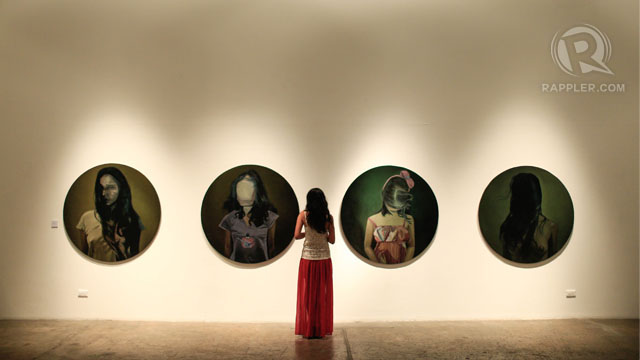
MANILA, Philippines – Being Carlo Gabuco is a difficult thing. He is both artist and activist, and the contradiction is an everyday struggle. Every image needs a reason; every picture needs a story. Gabuco does not believe in artistic masturbation. He cringes when he asked about what art is, he says he does not know. He is embarrassed by the idea of art for the sake of art, and hopes he always will be.
“I see a lot,” he says in Filipino. “I notice a lot, and you have to say it or it will stay in your head. I don’t want to live my life complaining all the time. Back then I was already painting, and I thought, maybe that was the way. I can’t answer why I’m still doing it. Maybe it’s because every time I found an answer, there was another question. Painting was what I knew. When I started asking questions, it was painting that I had. Maybe I could have gone howling in the streets, but that’s not how I speak.”
He paints what he shoots, has produced wall-sized oil paintings of Jovito Palparan and the drownings from Ondoy. His work is often violent, often painful, and very often leaves the viewer uncomfortable
“The way I work, I want to experience things first hand, as they happen. It’s one thing to read it, to see in a magazine, but it’s different when you’re there. I need to see it to fight for it.”
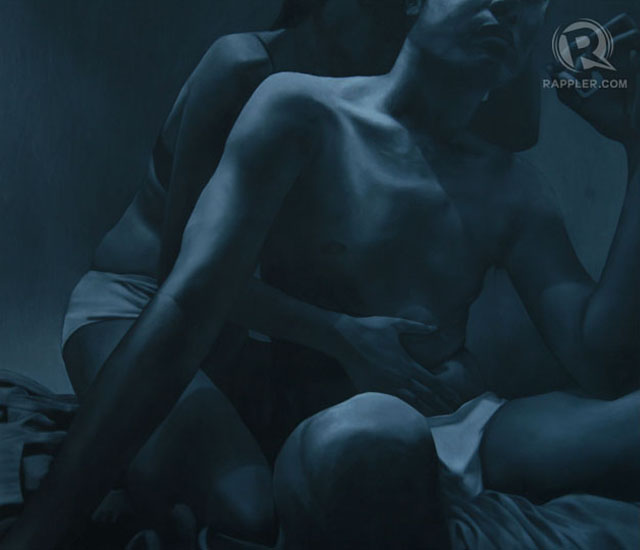
Art, he says, if it does nothing at all, should make the artist a finer man. It is what his old mentor told him, and what he continues to believe. He is nobody’s messiah, and is bothered by the awareness that what he does can do very little, and that he chooses to do it anyway instead of direct humanitarian work. Maybe he would have been happier painting naked girls while saying he is producing art, but for now at least he can say he is becoming a better person. Or at least he tries.
He still paints naked girls, but that is beside the point. The girls are representative, there is thinking behind the painting, and yes, the girl in most of the paintings is his girlfriend and they will live happily ever after.
Changing the world
Painting, for Gabuco, is a love-hate relationship, and has been since he was 15. When he achieves what he sees in his head, it’s the biggest possible high. When he doesn’t, he lets it pass.
“There was a time I used to get so frustrated,” he says. “But I learned. I’ve been doing it long enough. When I can’t produce, I don’t kick myself over it. I just sleep through it, and then I tell myself that tomorrow, I live to fight another day.”
Gabuco is 31. He graduated from the Philippine Women’s University, and has never held down a job that demands clocking in. His father was a racketeer of sorts, working as a caregiver in the United States, a money changer in Manila, and taking on every other odd job in between. His mother was a domestic helper in Hong Kong before working as a secretary for the Mandaluyong mayor’s wife.
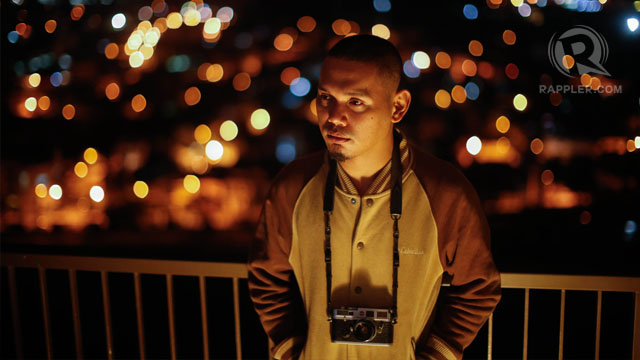
Gabuco knows what being poor means. He calls his current economic state struggling, and while his paintings are on the walls of millionaires and collectors, he still has trouble buying his own camera. He is philosophical about it. He is broke for most of the year, rich when he makes a sale, broke again weeks later. Sometimes it occurs to him he should give up on painting and get a proper job with a proper payday, but he hopes it will never happen.
He would like to be rich. He would maybe like to be famous. What he would really want is to paint and keep painting, keep shooting, keep using whatever medium is effective, but the one hindrance to jumping from medium to medium is always financial. The camera is expensive. So are the lenses, the editing programs, the electricity and overhead projectors and the occasional new white T-shirt.
“But that’s my fault, as an artist. If you’re an artist, the money shouldn’t be a hindrance. Maybe I procrastinate too much instead of finding a way around it. The money should just be a means, it shouldn’t matter.”
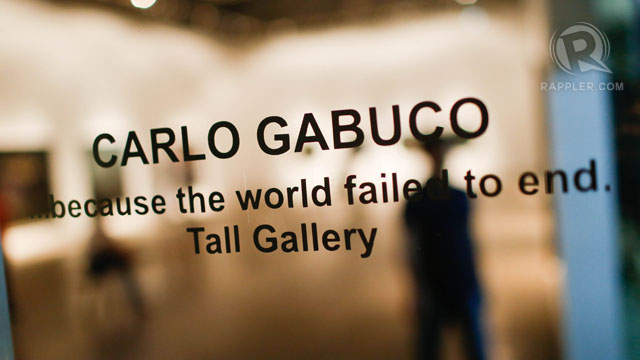
His Finale Gallery exhibit that launched on January 8, “…Because the world failed to end” is his most personal work.
“When I was conceptualizing this show, I thought, wait, I keep looking outside, but the apathy that I’m fighting is in myself. The diaspora that I’m condemning is happening in my own home. The tragedy I shoot is also my own tragedy. So this exhibit is for me to remember I’m part of the problem too.”
Exhibit notes from “…because the world failed to end”
There is a girl in the water. Her neck strains, the sun is on her face. There is effort to stay above water, but she does not fight the current. She does not mind, not this girl. She does not know she is drowning, if she did, maybe she would care.
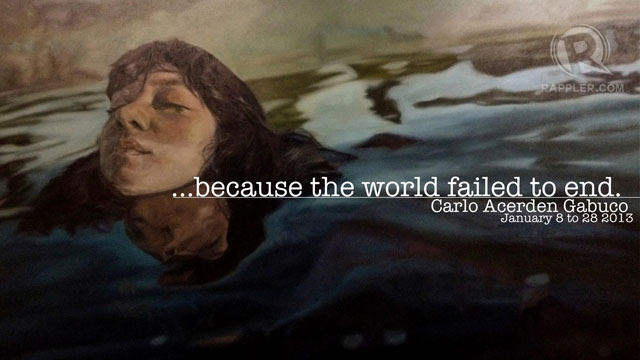
In the world created by Carlo Gabuco, a couple sleeps beneath grey fields. Faces are blurred and blank. A girl looks into the distance glassy-eyed. A man in a suit stands alone in an empty field. It is a story of a country whose people have been forced to leave families for money, of death counts that rise and the disappeared who are forgotten until the next pair of girls are stolen and raped with wooden sticks. It is a bad world, a sad world, and at the stillest point of this turning world is the painter who hopes to show not the sad or the bad, but the grim reality of acceptance.
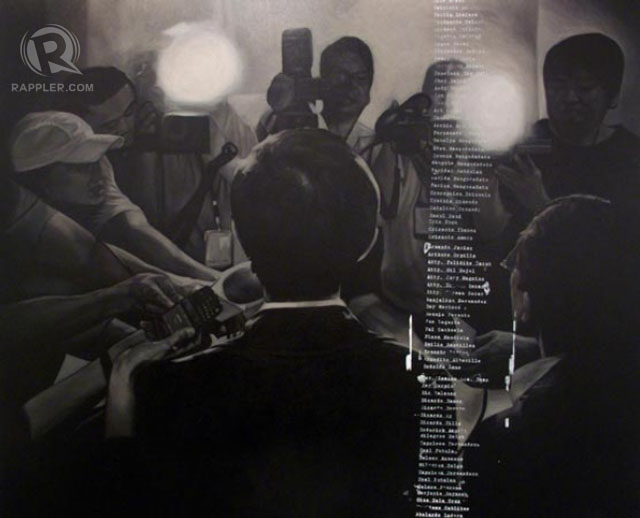
Because the world did not howl when 400 drowned in a city of floating water lilies, a family of 9 was buried underground on the day the sky fell. Because the world forgot their outrage at the image of a backhoe scraping a hillside beside the bodies of 58, warlords continue to arm the same sort of men who will kill for the price of a pair of rubber slippers.
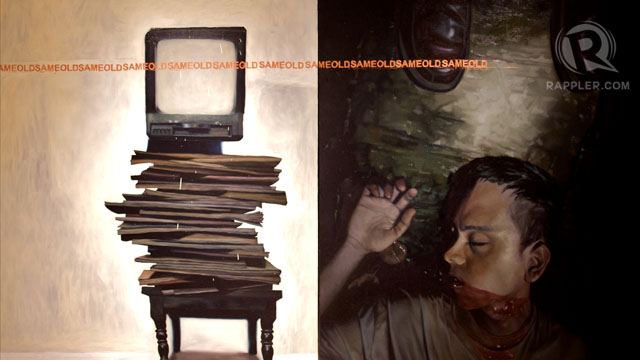
The exhibit is not a lecture. It is, instead, an attempt to remember by a man who hopes he will not forget. Gabuco is the painter who stands at the center of a rally fenced by elbows and red banners. He is there when the butcher grins before clicking shutters, he is there to document the drowning dead. Every painting is personal, they are not documentary as much as they are memories of loss and distance and the loneliness. He has seen, and continues to see, and by seeing believes he is as responsible as the others who have chosen not to see. His gift is imagination, the willingness to feel the guilt of living in a world slowly going to hell.
This is what happens when the world fails to end. The dead become nameless. The lost remain lost. The exodus continues, father and mother and cousin and the girl who used to live next door. Because the world failed to end, those who live will continue to live sleeping, until their own worlds end while the rest continue to live. – Rappler.com
Because the world failed to end is showing at the Finale Art File, Warehouse 17, La Fuerza Compund, Gate 1 2241 Pasong Tamo, Makati City until January 28, 2013. Telephone numbers (632) 8132310, 8125034. Fax (632) 8104071.
Add a comment
How does this make you feel?
There are no comments yet. Add your comment to start the conversation.